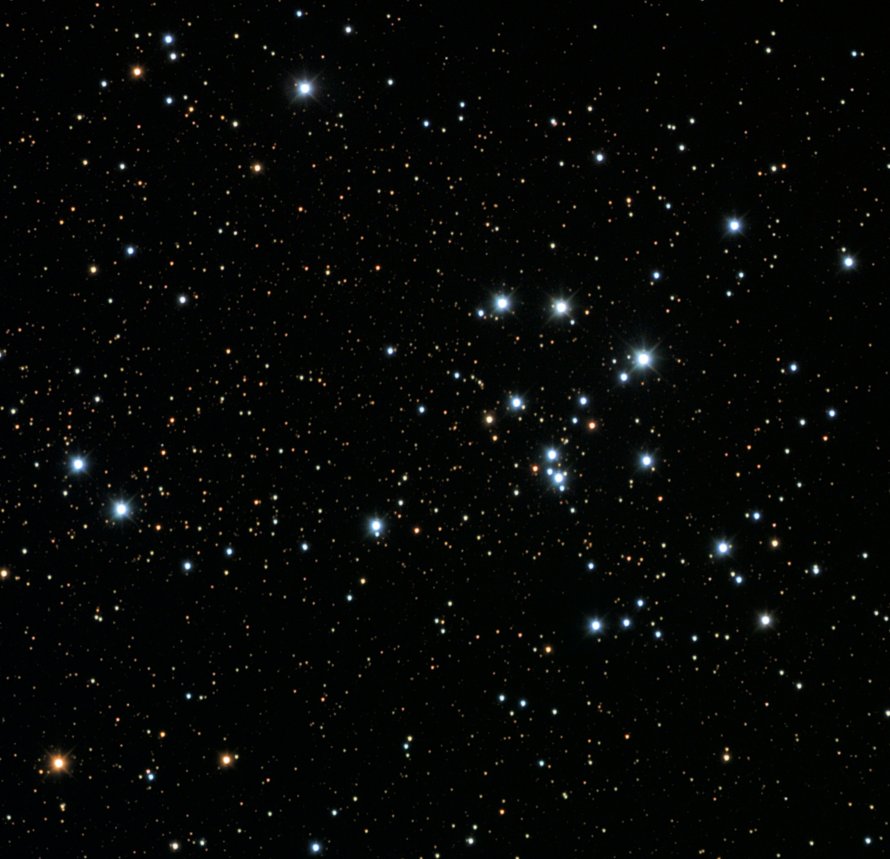M18 (NGC 6613)
Messier 18 (NGC 6613) is an open cluster located in the constellation Sagittarius, in the Sagittarius Arm of the Milky Way Galaxy in the Local Group of galaxies. M18 is 4200 light years away from Earth.
M18 is best viewed during late summer, is magnitude 7.5, and can be viewed with binoculars. M18 is 10' in apparent size. For reference, the full moon is 30'.
Observing difficulty: Easy
- Name:
- Type:
- open cluster
- Constellation:
- Sagittarius
- NGC or IC:
- NGC 6613
- Magnitude:
- 7.5
- Viewing:
- binoculars
- Size:
- 10'
- Distance (light years):
- 4200 LY
- RA:
- 18h 19.9m
- Dec:
- -17 8'
- Season:
- late summer
- Milky Way location:
- Sagittarius Arm
- Galaxy group:
- Local Group
- Messier Marathon #:
- 92
* The naked eye can see up to magnitude ~7-8 objects under ideal dark sky conditions.
An Intimate Look at a Young Open Cluster
Within the constellation Sagittarius lies Messier 18 (M18), an open star cluster that provides an exciting insight into stellar youth and evolution. Although smaller and less populated than other clusters, M18 captivates astronomers with its ensemble of vibrant stars. In this article, we explore M18's discovery, its physical and stellar characteristics, its magnitude, and offer tips on how to locate and observe this fascinating cluster.
Discovery and Observation
M18 was first cataloged by the French astronomer Charles Messier on June 3, 1764. It's approximately 4,900 light-years away from us and provides a beautiful view through a small telescope, where it appears as a faint grouping of stars set against the rich backdrop of the Milky Way.
Physical Characteristics and Magnitude
Spanning about 17 light-years, M18 is relatively small for an open cluster. It contains about 20 stars, the brightest of which are of spectral types B3 and B9. Despite its distance, M18 shines at an apparent magnitude of 7.5, which, while not visible to the naked eye, can be seen through a pair of binoculars or a small telescope, revealing its stars as a scattered, loose grouping.
Stellar Composition
M18 is one of the younger open clusters known, with an estimated age of only about 32 million years. Its population is dominated by young, hot blue and white stars, a typical characteristic of a young cluster. The presence of these young stars offers an exciting opportunity to study stellar formation and early evolution.
Astronomical Significance
Even though M18 isn't as rich in stars as other open clusters, its relatively young age makes it a noteworthy subject in astronomical research. It provides researchers an opportunity to study a relatively young stellar environment and understand the processes of stellar formation and evolution. The cluster's youthful stars serve as the perfect specimens for examining stellar life cycles.
Finding and Viewing M18
Finding M18 is straightforward. It resides in the constellation Sagittarius, which is best visible during the summer months in the Northern Hemisphere. M18 is conveniently situated near two other Messier objects, M17 (the Omega Nebula) and M24 (the Sagittarius Star Cloud), forming a triangle that can guide observers. With binoculars or a small telescope, M18 appears as a faint, diffuse patch of light, with a larger telescope resolving its individual stars.



